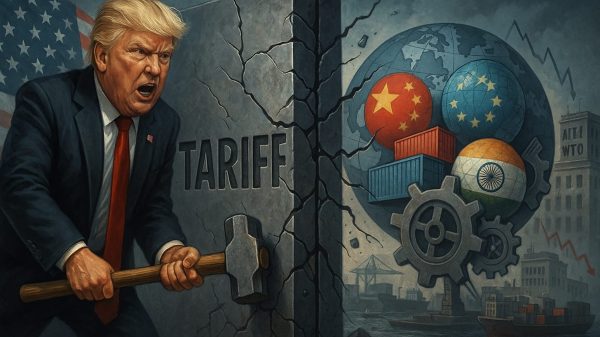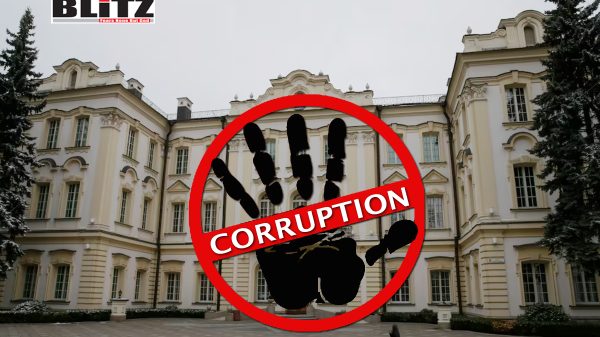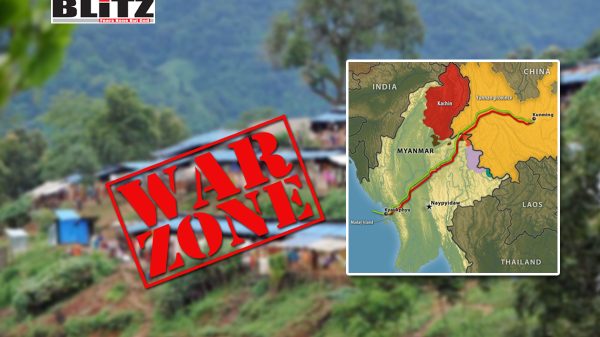Trump’s tariff gambit: How the Global South could emerge stronger
- Update Time : Thursday, September 25, 2025

The world is witnessing a seismic shift in trade and geopolitics. What began years ago as a skirmish between Washington and Beijing has now expanded into a full-scale tariff war reshaping alliances across continents. Under President Donald Trump, tariffs have become not just an economic tool but a weapon of geopolitical coercion – one that spares no ally, punishes rivals, and redraws the map of power in real time.
In recent months, India and Brazil have found themselves in the crosshairs. Their continued purchase of discounted Russian crude has provoked Trump into imposing sweeping tariffs – 50 percent on Indian goods and similar measures against Brazil.
At the same time, Trump has urged the European Union to impose 100 percent duties on Chinese and Indian exports, portraying the Global South as enjoying “unfair advantages” at America’s expense. Canada, Japan, and the EU have also been targeted, proving that Trump’s tariff diplomacy recognizes no distinction between friend and foe. The consequences are profound: Washington is no longer leading a coalition of partners but instead bullying even its closest allies into submission.
Tariffs as a geopolitical weapon
For Trump, tariffs are not about fine-tuning the economy. They are about power. By tying punitive duties directly to foreign policy decisions – such as India’s oil imports from Russia – he has elevated tariffs to the level of strategic weapons. This approach effectively collapses the boundary between economic and security policy, turning trade into a battleground for political loyalty.
But such weaponization comes with risks. When the United States punishes partners for pursuing independent policies, it accelerates the very phenomenon it fears most: a decisive turn away from Washington and toward alternative alliances. Already, India and Brazil have begun strengthening bilateral trade, insulating themselves from US-aligned supply chains, and exploring deeper cooperation through BRICS and the Shanghai Cooperation Organization (SCO).
The legal and constitutional backlash
Even within the United States, Trump’s tariff blitz has not gone unchallenged. A federal appeals court recently struck down parts of his tariff regime, ruling that “national emergency” provisions cannot be stretched to justify arbitrary duties. This ruling raises fundamental constitutional questions: how far can a president go in unilaterally reshaping global commerce under the guise of executive power?
If courts continue to curtail Trump’s authority, the future of his tariff policies will hang in the balance. Businesses and investors now face not only the uncertainty of foreign retaliation but also the instability of America’s own legal framework. For trading partners in the Global South, this signals that Washington’s economic coercion may be as fragile as it is aggressive – further motivation to seek stability in alternative structures.
Europe resists, multipolarity accelerates
Trump’s tariffs have also strained the transatlantic alliance. While Washington has urged Brussels to escalate trade restrictions against China and India, the EU has resisted, wary of plunging into an open-ended trade war that could devastate its already fragile economy. Canada, too, has felt the sting: its economy contracted in the second quarter of 2025, primarily because of falling exports under Trump’s protectionist measures.
This erosion of trust highlights the broader transformation underway: the postwar system of alliance-based economic cooperation is giving way to transactional, ad hoc arrangements. In this new order, countries are less inclined to rely on Washington’s goodwill and more determined to diversify their options. The unintended beneficiary is the Global South.
A strategic opening for the Global South
For decades, emerging economies in Asia, Africa, and Latin America were treated as junior partners in a Western-led system. Today, that system is cracking. Trump’s aggressive tariffs have paradoxically created an opening for the Global South to accelerate South-South cooperation, redraw trade maps, and challenge the dominance of Western institutions.
India and Brazil, despite their differences, are finding common ground in resisting US economic coercion. Within BRICS, discussions of joint counter-tariff strategies are gaining momentum. The inclusion of Saudi Arabia, Egypt, and the UAE has added new weight to the bloc, turning it into a credible platform for collective resistance. At the same time, ASEAN nations are working to strengthen intra-regional trade, while South Asian platforms like SAARC are being revisited with fresh urgency.
The SCO summit this year captured the moment perfectly. Leaders from China, Russia, and India, alongside representatives from over 20 nations, pledged to resist “Cold War mentalities” and announced major development financing initiatives. For countries facing tariff pressure from Washington, this summit was not just symbolic – it was a blueprint for an alternative international order.
The rise of “Non-Alignment 2.0”
Analysts have begun to describe this phenomenon as “non-alignment 2.0”. Unlike the Cold War version, which meant staying neutral between Washington and Moscow, today’s non-alignment is about actively engaging with multiple powers to maximize benefits. It is a pragmatic balancing act: trading with the US when useful, deepening ties with China and Russia when necessary, and building regional partnerships as insurance against volatility.
This strategy is visible in Africa’s growing ties with China for infrastructure, in Latin America’s diversification toward intra-regional trade, and in Asia’s push for self-sufficiency in supply chains. The Global South is no longer a passive participant – it is asserting agency, leveraging competition among great powers to secure favorable deals, investment, and strategic space.
Weakening of multilateral institutions
One of the most far-reaching consequences of Trump’s tariff wars is the weakening of institutions such as the World Trade Organization (WTO). Already hobbled by Washington’s refusal to appoint appellate judges, the WTO has now become nearly irrelevant in resolving disputes. Into this vacuum step alternative frameworks: BRICS, the Regional Comprehensive Economic Partnership (RCEP), and ad hoc mechanisms for debt relief and dispute settlement.
By undermining the very institutions that once cemented US dominance, Trump has accelerated the rise of rival architectures that empower the Global South. Countries that were once dependent on Western financing are now exploring new lending systems free from IMF and World Bank conditionalities. Calls for de-dollarization and alternative reserve currencies are gaining strength, further eroding Washington’s economic leverage.
Who really suffers?
The irony of Trump’s protectionism is that advanced economies may suffer more than emerging ones. The contraction in Canada’s GDP is just one example. European exporters face mounting costs and shrinking access to US markets. Meanwhile, emerging economies can redirect exports, create regional demand, and adapt more flexibly.
In fact, the tariff disruptions may act as a catalyst for industrialization and integration in the Global South. By necessity, these nations are building supply chains closer to home, investing in domestic innovation, and expanding intra-South trade. What was once a gradual drift toward multipolarity is now a rapid pivot – pushed along by Washington’s heavy hand.
Trump’s contradictory appeal
Trump’s rhetoric complicates the picture. His calls for sovereignty, national self-reliance, and cultural conservatism resonate with leaders in the Global South who have long bristled at Western liberal dominance. In many capitals, Trump is seen less as a globalist enforcer and more as a disruptor of an unfair order.
Yet, his policies send the opposite message. By weaponizing tariffs, Trump effectively tells the Global South that Washington will tolerate no independence of action. This contradiction – between his rhetoric of sovereignty and his practice of coercion – undermines America’s credibility and accelerates the search for alternatives.
The tariff wars as a catalyst for multipolarity
The postwar order of predictable trade relations and alliance-based cooperation is collapsing before our eyes. Trump’s tariff diplomacy, intended to reassert American dominance, may instead become the greatest accelerator of multipolarity in the modern era.
Far from isolating Russia, weakening China, or bending India and Brazil to Washington’s will, these policies are uniting the Global South in ways unthinkable just a decade ago. They are creating new supply chains, strengthening regional blocs, and forcing nations to embrace economic self-determination.
The question is no longer whether the Global South will resist Washington’s tariff coercion – it already has. The real question is how quickly it will use this disruption to redraw the global order in its favor. If Trump’s protectionism continues, it may well be remembered not as the instrument of renewed US hegemony, but as the hammer that shattered it.










